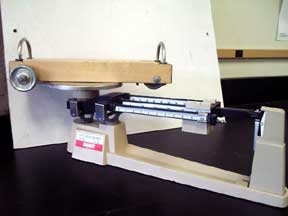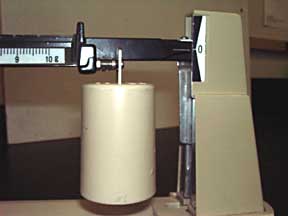|
|
|
|
|
|
|
|
|
|
|
|
|
|
|
|
|
Conservation of Momentum
|
|
|
|
|
|
|
The purpose of this activity is to test the Law of Conservation of Momentum. If the momentum of a closed, isolated system is zero before an explosion, the momentum of the system after the explosion should still be zero.
You will pre-load the spring of a dynamics cart and create an explosion between it and another cart in the system.
Your task will be to set up the experiment as indicated below, calculate the momenta of two carts after an explosion, add the two momenta and compare to the zero condition before the explosion.
To calculate the momenta of each cart, it seems that you would need mass and velocity of each cart after the collision. Mass can be pre-determined. Velocity requires a measurement of both distance and time for each cart. You can easily find the distances each cart travels.. and you can worry about the time later. |
|
|
|
|
|
|
Tools and equipment you'll need:
| triple beam balance |
1.0 kg. counterweight |
500 g. mass |
| 2 similar dynamics carts |
2 wood blocks |
2 "C" clamps |
| masking tape |
pencil |
meter stick |
|
|
|
|
 |
|
|
|
|
|
|
|
|
|
You'll need to mass each cart. Your triple beam balance can only mass up to about 610 grams, and the carts mass more than this, so you'll need to add a 1.0 kg. counterweight to the balance as shown below. The counterweight doesn't actually mass to 1.0 kg. itself. |
|
|
|
|
 |
|
|
|
|
Setup the two carts near the middle of your lab table like this. The plungers should be both pushed in and 'set' as shown. Place the plunger end of one cart next to the solid end of the other. |
|
|
|
|
|
 |
|
 |
|
|
|
|
|
|
|
 |
|
To create your 'explosion', you'll release the carts by pressing the plunger of one cart as shown at left. The carts will then both move away in opposite directions toward the boundaries of the 'system': two boards clamped to the ends of the table with "C" clamps as shown. |
|
|
|
|
|
 |
|
|
|
|
Conduct several explosions until you find a starting point on the table which results in both carts hitting their respective boundaries at exactly the same time! |
|
|
|
|
|
 |
|
|
|
|
|
|
You'll need to listen for the carts to hit the boundaries. When they make only one sound between them, they are striking their boundaries at the same time. This means that they both travel the same amount of time. You don't know what this amount is, but you can ( and WILL!) show that time cancels out of the expression in this case. You'll still need a UNIT of time for your momentum calculations. Make up a time unit. Make up a unit of time, name it after yourself, and say that each cart traveled for exactly 1.0 of your new time units. |
|
|
 |
|
|
|
|
|
When you are satisfied that both carts travel for the same amount of time to reach their respective stop points, mark the starting point on your table top with tape and a pencil mark. Measure the distance each cart traveled. Don't assume the carts are the same length. Be careful to only measure the exact distance each cart traveled. Then repeat the trial with an additional mass taped securely to one of the carts. |
|
|
|
|
 |
|
|
|
|
|
This lab requires a full write up. You have 5 class days in which to turn in your report. Be sure to turn in a lab form with it. |
|
|
|
|
|








